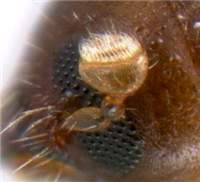Diagnosis
Minute species. Main character: scutellum minute, conical, surrounded by setae, in a notch between elytral bases. Pronotum often elongated, pronotal disc matt, alutaceous. Antennal club type 1, truncated, with corneous segment 1 dominant on both sides. Elytral declivity often tapering, often with numerous pointed asperities.
Distribution
Common worldwide, both in the tropics as well as temperate regions. Xyleborinus saxeseni is among the most widespread beetles in the world.
Biology
True xylomycetophages, where larvae chew on xylem surrounding the communal chamber, and assist in gallery expansion.
Taxonomy
Monophyletic, easily defined by conical scutellum.
Detailed description
Eyes deeply emarginate, upper part smaller than lower part. Antennal club taller than wide, club type one (truncated, segment 1 covering posterior side), or two (obliquely truncated, segment 2 visible on posterior side). Segment 1 prominent, covering most of anterior and nearly all posterior side, its margin concave, fully costate. Segment 2 and 3 of club narrow, pubescent, visible on anterior side only. Segment 1 of antennal funicle shorter than pedicel, funicle 4-segmented, scapus regularly thick. Frons above epistoma rugged, coarsely punctate. Submentum deeply impressed, shaped as very narrow triangle. Anterior edge of pronotum with no conspicuous row of serrations (serrations no different than on pronotal slope). Pronotum from lateral view elongated, with low summit (type 7). From dorsal view it has elongated basic shape with rounded frontal margin (type 7). Pronotal disc shining or smoothly alutaceous, with small punctures, lateral edge of pronotum obliquely costate. Procoxae contiguous, prosternal posterocoxal process short and conical, or flat and inconspicuous, or tall and pointed, or conical and slightly inflated. Tuft on pronotal basis associated with mesonotal mycangium absent, but elytral bases bear dense tuft of setae around small conical scutellum, associated with elytral mycangium. Elytral bases mostly straight, notched around conical scutellum. Elytral disc longer than declivity, flat, punctures on elytral disc in strial lines. Boundary between elytral disc and declivity distinct, or sometimes indistinct when disc is rounded and smoothly transitioning into declivity. Lateral profile of elytral declivity slightly to distinctly convex, often steep, especially towards apex, or in some species very slowly descending and almost flat. Dorsal profile of elytral apex rounded, or elongated apically, attenuated or angulate. Elytral declivity covered with few sparse setae. Posterolateral declivital costa absent or very short. Inner part of declivity with several tubercles on interstriae 1, 3 and beyond, no tubercles on interstria 2. Tubercles in interstriae 1 sometimes absent, or present as minor granules. First interstriae parallel on disc but broadened towards apex of elytra. Protibiae obliquely triangular, broadest at 2/3 of length. Posterior side of protibia flat, no granules, only setae. Protibial denticles small, or large, distinctly longer than wide, bases of denticles not enlarged, protibial margin rounded, fewer than 6 protibial denticles present. Metatibiae of normal size. Color dark brown or black; pronotum sometimes slightly lighter. Usually minute species, length: 1.4-2 mm., length beyond 2 mm is rare.




